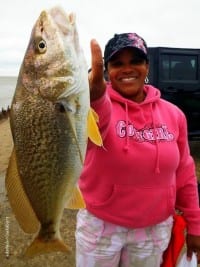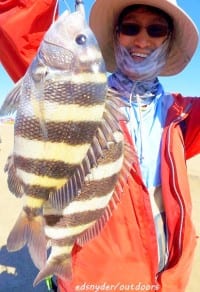 By Ed Snyder/Outdoors
By Ed Snyder/Outdoors
Concerning the saltwater drum species found in Texas Coastal areas, there is “some” confusion on the differences betwixt the Red and Black Drum. Although they are of the same family, they are markedly different in coloration, feeding and spawning habits, as well as the value on which drum anglers prefer to catch. Both are very hard fighters though, but with different traits when it comes to the fight. Red Drum or Redfish, reds, or spot-tails as they are referred to by Texas anglers, have a tendency to run hard in all directions, eventually showing their acrobatics on the surface when hooked by anglers. Black Drum, however, are dogged fighters keeping on the bottom and just giving the angler a tug-o-war workout until finally succumbing to the net.
The red drum (Sciaenops ocellatus), also known as channel bass, redfish, spottail bass or simply reds, is a game fish that is found in the Atlantic Ocean from Massachusetts to Florida and in the Gulf of Mexico from Florida to Northern Mexico. It is the only species in the genus Sciaenops. The red drum is a cousin to the black drum, and the two species are often found in the same vicinity.

This angler shows the differences, with the red on the left and the drum on the right
The black drum (Pogonias cromis), or Channel Bass, is a saltwater fish similar to its cousin, the red drum. It is the only species in the genus Pogonias. Though most specimens are generally found in the 5 to 30 lb range, the black drum is well known as the largest of all the drum family with some specimens reaching 90 lbs. The world record black drum is 113 lbs. They are often black and/or gray in color with juvenile fish having distinctive dark stripes over a gray body. But some have been caught sporting a reddish hew color. Their teeth are rounded with powerful jaws capable of crushing oysters, crabs, and other shellfish. It is recommended those over 15 lbs pounds should be released. Black drum are capable of producing sound tones between 100 Hz and 500 Hz when performing mating calls.
Red or Black drum are one of hundreds of species that make sounds. Many of the sounds are part of the mating ritual, although others can serve as warnings or as calls to family. In the case of red, the sounds come from males who are trying to attract females. They make sound by contracting the muscles around the swim bladder – basically a small airbag that helps the fish control its depth. These muscles are strong and fast. When the fish squeezes them in a hurry, it creates a pressure wave that travels through the water as sound.

Surf angler shows off this reddish hued Black Drum, which are often mistaken for red-fish
The red drum is a popular game fish in coastal waters from Massachusetts to Mexico. Red drum is considered a great sport fish because it will hit on most kinds of bait. The Texas record for a red drum catch is 59.5 pounds (23 kg); however, a red drum weighing 94 pounds (42.69 kg) was caught along the North Carolina coast.
Red drums prefer shallow waters (1-4 feet deep) along the edges of bays with submerged vegetation such as sea-grasses. They are found over all bottom types but they seem to prefer areas with submerged vegetation and soft mud. These fish are also commonly found around oyster reefs. Breaks in shorelines such as coves, points, jetties, old pier pilings, and guts attract them. They are often found in water so shallow that their backs are exposed while swimming. During cold spells, large numbers of red drum can be found in tidal creeks and rivers.
For the first three years of their lives, red drum live in the bays or in the surf zone near passes. Evidence from tag returns show that they remain in the same area and generally move less than 3 miles from where they were tagged. As they mature, they move from the bays to the Gulf of Mexico where they remain the rest of their lives, except for infrequent visits to the bays. Although there is little evidence of seasonal migrations, anglers find concentrations of red drum in rivers and tidal creeks during the winter. Daily movement from the shallows to deeper waters is influenced by tides and water temperatures. During the fall, especially during stormy weather, large adult red drum move to the gulf beaches, possibly for spawning, where they can be caught from piers and by surf anglers. This is known as the “bull red-fish run.”

Often confused with a red-fish, this big croaker also drums like a drum
Young red drum (rat-reds) feed on small crabs, shrimp, and marine worms. As they grow older, they feed on larger crabs, shrimp, small fish, and sometimes their cousins, the Atlantic croaker. They generally are bottom feeders but will feed in the water column when the opportunity arises. A phenomenon called “tailing” occurs when the red drum feed in shallow water with their head down in the grass and the tail exposed to the air. Predators include humans, birds, larger fish, and turtles.
Between the third and fourth year, the red drum reaches sexual maturity. Spawning season is from mid-August through mid-October in Gulf waters, near the mouths of passes and shorelines. Eggs incubate for 24 hours. Larvae are carried into tidal bays by the current. They move to quiet, shallow water with grassy or muddy bottoms to feed on decomposing plant and animal matter. The oldest recorded red drum was 37 years old!
During spawning, red drum males attract females by producing a drum-like noise by vibrating a muscle in their swim bladder. They sometimes swim in water so shallow that their backs are exposed.
Red drum are related to black drum, speckled trout, mullet and croaker, most of which also make drumming sounds. Scientists believe that the black spot near their tail helps fool predators into attacking the red drum’s tail instead of their head, allowing the red drum to escape.
A few years ago, researchers listened in on the redfish along the Texas coast during mating season. They towed an underwater microphone behind a boat as they sailed along a grid in the Gulf of Mexico. The scientists found that the mating chorus began in late afternoon, picked up around sunset, and grew to a roar in the evening. A female may be attracted by a certain frequency or loudness – traits that may indicate a male’s strength and vitality. When she finds the right call, she releases her eggs and the male fertilizes them. So a loud “drum beat” plays a role in keeping the red-fish population strong.

Huge Black Drum caught on a soft plastic lure
Black drum spawn between January and April, between 7 and 10 pm, and at water temperatures of 59 to 75°F. During this period, each female spawns 20 to 30 times. Spawning peaks seem to occur at new and full moon phases and spawning takes place in the early evening, one to two hours after sunset. After being spawned, the eggs are carried seaward by currents until they hatch. Larval (baby) and small black drum (puppy-drum) then tend to travel inland with incoming tides where they settle out in marshes to grow.
At 24 to 26 inches and 4 to 5 years of age, they become sexually mature and begin to spawn where they form large schools before they begin to spawn. Often 20,000 – 60,000 pounds of fish will be in one of these offshore schools, frequently mixed with cow-nose rays and occasionally jack crevalle and red drum. After spawning season, these schools seem to disperse. Black drum are long-lived fish, with most studies indicating a maximum age of over 40 years and one study in Florida estimating a maximum of 58 years of age.
Now, despite the differences spelled out in this article, I’m confident that at sometime during this year some anglers will make the mistake of trying to tag an oversized black drum mistaking it for a red, or keep a 29 or 30 inch red-fish they see as a drum. You can’t fix stupid, we’ll leave it up to the Texas Game Warden’s to solve that problem. But we, who believe in conversational rules and regulations to preserve our natural resources for the enjoyment of future anglers, hope that we can make a difference for that end.
Present TPWD fishing regs allow anglers to keep 3 red-drum from 20 to 28 inches daily, with one over 28 inches when properly tagged from your fishing license.
Present TPWD regs for black drum allow anglers to keep 5 drum daily from 14 to 30 inches with NO black drum over 30 inches allowed. Any drum over 30 inches MUST be released.

Another species often mistaken as drum are these Sheepshead
Both species, the red and the black, are exceptional table fare. The red is the favorite among anglers and rightfully so, with hundreds of recipes giving the red-fish almost cuisine status at most restaurants. BUT IS THAT ACTUALLY RED-FISH you’re being served, Black drum are just as tasty, when it’s caught out of cold water. But so too the red. Any fish caught from cold waters are tastier when prepared.
I could take a black drum filet and cook it with any red-fish recipe of your choice and you wouldn’t be able to tell the difference. The trick with black drum is it’s minimum keeper size of 14 inches as opposed to the 20 inch minimum on red-fish. When fish get bigger they’ll have coarser flesh which ebbs the flavor of the fish. So smaller is better. Also the key for keeping your catch fresh and tasty for the table is to ALWAYS ice your catch in the cooler. This will insure that the flavor of that fish, red or black, will still be fresh and delicious.

This anglerette managed to catch and tag this bull red-fish
INFO GUIDES
Wikipedia, Google, TPWD
This Ed Snyder/Outdoors Article
Sponsored by:
Miss Nancy’s Bait Camp
The Beach Triton
FishingWorld.Com
CrystalBeachLocalNews.com
(This article published 2/9/2015)

 Posted in
Posted in 
























They are fairly easy to tell apart, but when in doubt, look for the goatee!
Good article Ed!!